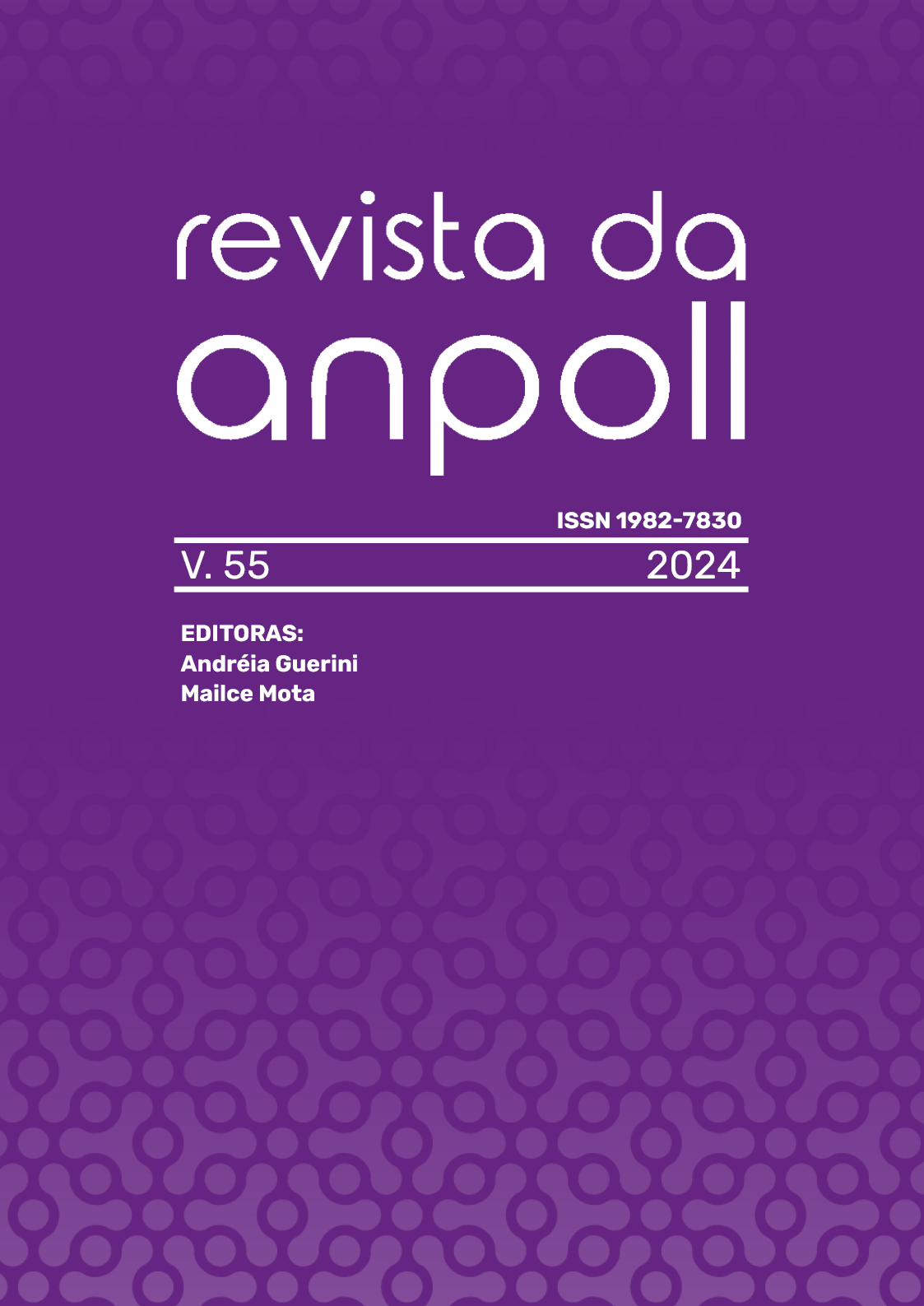On the morphological productivity of the suffixes -ção and -mento:
a diachronic perspective
DOI:
https://doi.org/10.18309/ranpoll.v55.1943Keywords:
produtividade morfológica, nominalizadores –ção e –mento, diacroniaAbstract
In the present work, we address the variation in the morphological productivity of the nominalizing suffixes –ção and -mento from a diachronic perspective, based on a pilot study on the dating of words contained in the electronic version of the Houaiss Dictionary of the Portuguese. Our results showed that until the 15th century there were more forms with the suffix -mento. However, this trend reversed from the 16th century onwards, with a robust increase in forms in -ção, with a growth peak in the 19th century. We argue that these results interestingly align with Tang and Nevins' (2013) diachronic corpora study. The hypothesis we defend is that the massive increase in the vocabulary of the first conjugation had a positive implication in the increase in productivity of the suffix –ção, since there was a significant increase in the number of targets/bases relevant to the application of this morphological process. Considering the grammar architecture of Distributed Morphology (Halle; Marantz, 1993, 1994) and the notion of markedness, we propose a theoretical interpretation in terms of a hierarchy of markedness for the verbal thematic classes of BP that can clarify the preference relationship that we attest between thematic classes and nominalizing suffixes in focus in this study (cf. XXXXX, 2014).
Downloads
References
ANDREWS, E. Markedness theory: the union of asymmetry and semiosis in language. Duke University Press. 1990.
ARONOFF, M. Word formation in Generative Grammar. Cambridge, MA: The MIT Press. 1976.
ARONOFF, M. Morphology by itself: stems and inflectional classes. Cambridge, MA: The MIT Press. 1994.
ARONOFF, M; ANSHEN, F. Morphology and the lexicon: Lexicalization and productivity. In:
SPENCER, Andrew; ZWICKY, Arnold (Eds.) The handbook of morphology. Oxford: Blackwell, 1998. p. 236-247
ARONOFF, M.; LINDSAY, M. Productivity, blocking, and lexicalization. In: R. Lieber & P. Štekauer (Eds.). The Oxford handbook of derivational morphology. Oxford: Oxford University Press, 67-83. 2014.
BASÍLIO, M. Estruturas lexicais do português: uma abordagem gerativa. Petrópolis: Vozes, 1980.
BASÍLIO, M. Formação e Uso da Nominalização Deverbal Sufixal no Português Falado. In: CASTILHO, Ataliba; BASÍLIO, Margarida. (org.) Gramática do Português Falado. Vol. IV: Estudos Descritivos. Campinas: Editora da Unicamp / São Paulo: FAPESP, 1996a.
BAUER, L. Morphological productivity. Cambridge studies in Linguistics 95. Cambridge, UK: Cambridge University Press. 2001.
BOOIJ, G. E. Dutch Morphology: A Study of Word Formation in Generative Grammar. Dordrecht: Foris. 1977.
BOOIJ G.; RUBACH, J. Postcyclic versus Postlexical Rules in Lexical Phonology. Linguistic Inquiry, Vol. 18, No. 1 (Winter, 1987), pp. 1-44. 1987.
BONET, E. Morphology after syntax: Pronominal clitics in Romance. Ph. D. Dissertation. MIT. 1991
CHOMSKY, N.; HALLE, M. The sound pattern of English. NY: Harper & Row. 1968.
DI SCIULLO, A.-M. & E. WILLIAMS. On the definition of word. Cambridge, MA & London: MIT Press. Dubinsky, S. & S. R. Simango. 1996. ‘Passive and stative in Chichewa: Evidence for modular distinctions in grammar.” Language 72. 749-781. 1987.
DIK, S.C. 1967. Some critical remarks on the treatment of morphological structure in transformational generative grammar. Lingua 18: 352–383
EMBICK, D. Localism versus Globalism in Morphology and Phonology. Cambridge, MA: MIT Press. 2010.
XXXXXXXXXXXXXXXXXXXXXXXXXXXXXXXXXXXXXXXXXXXXXXXXX. In: Cadernos de Estudos Linguísticos v. 56.1; Campinas, 2014.
XXXXXXXXXXXXXXXXXXXXXXXXXXXXXXXXXXXXXXXXXXXXXXXXX. Tese de Doutorado. Universidade Estadual de Campinas, Instituto de Estudos da Linguagem. Campinas, SP. 2015.
XXXXXXXX. Estudo experimental sobre os nominalizadores –ção e –mento (no prelo).
HALLE, M.; MARANTZ, A. “Distributed Morphology and the Pieces of Inflection,” in Kenneth Hale and Samuel Jay Keyser, eds., The View from Building 20: Essays in Linguistics in Honor of Sylvain Bromberger, MIT Press, Cambridge, MA, 111–176. 1993.
HALLE, M.; MARANTZ, A. Some key features of distributed morphology. MIT Working Papers in Linguistics 21: Papers on phonology and morphology. p. 275–288. Cambridge, MA: MIT Press. 1994.
HOUAISS, Antônio et al. Dicionário eletrônico Houaiss da língua portuguesa. Rio de Janeiro: Objetiva, 2001. 1 CD-ROM.
JAKOBSON, R. "The Structure of the Russian Verb", reprinted in Russian and Slavic Grammar Studies, 1931–1981, Mouton, 1984.
KIPARSKY, P. "Elsewhere in Phonology", in S. R. Anderson and P. Kiparsky, eds., A Festshrift for Morris Halle. New York: Holt, Rinehart and Winston, 93-106. 1973.
LIEBER, R. On the organization of the lexicon. Doctoral Dissertation, MIT. 1980.
MARONEZE, Bruno. Um estudo da mudança de classe gramatical em unidades lexicais neológicas. Tese de Doutorado. São Paulo: USP, 2011.
NEVINS, A. DAMULAKIS, G. e FREITAS, M.L. Phonological regularities among defective verbs. In: Cadernos de Estudos Linguísticos v. 56.1; Campinas, 2014.
OITICICA, J. Manual de análise (léxica e sintática). São Paulo: Editora Paulo de Azevedo Ltda. 1955.
OLTRA-MASSUET, I. On the notion of theme vowel: A New Approach to Catalan Verbal Morphology. Master thesis. MIT, Cambridge, MA. 1999.
OLIVEIRA, S. M. Os sufixos nominalizadores –ção e –mento. Estudos Linguísticos XXXVI(1). 2007.
TANG, K.; NEVINS, A. Quantifying the Diachronic Productivity of Irregular Verbal Patterns in Romance. UCL Working Papers in Linguistics 25. 2013.
Downloads
Published
How to Cite
Issue
Section
License
Copyright (c) 2024 Revista da Anpoll

This work is licensed under a Creative Commons Attribution 4.0 International License.
Os trabalhos publicados na Revista da Anpoll são licenciados sob os termos da licença Creative Commons Atribuição 4.0 Internacional. Assim, os/as autores/as ou terceiros podem copiar e redistribuir o material licenciado em qualquer suporte ou formato, e remixar, transformar, ou criar a partir do material desde que sejam dados os devidos créditos ao trabalho original. Ressalta-se que a redistribuição, transformação ou criação, de iniciativa de dos/as autores/as ou de terceiros, deve mencionar a precedência de sua publicação neste periódico, citando-se o volume, número e data desta publicação.






